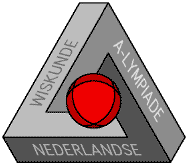 Math A-lympiad: Preliminary
1993-1994
Math A-lympiad: Preliminary
1993-1994 Math A-lympiad: Preliminary
1993-1994
Math A-lympiad: Preliminary
1993-1994If a decision is to be taken by a vote, the voting method can often decide the outcome of the vote. To illustrate this look at the following example:
A grade 11-class goes on a school trip to Rome. On the outward journey they
will spend a few days in Venice, Florence or Siena. The participating students
can vote on this.
Every student has his own preference, for example Venice, Siena, Florence. this
means: first choice Venice, second choice Siena and third choice Florence.
The preferences of the 31 students are as follows:
| first choice | second choice | third choice | total |
| Florence | Venice | Siena | 5 |
| Florence | Siena | Venice | 7 |
| Venice | Florence | Siena | 3 |
| Venice | Siena | Florence | 7 |
| Siena | Florence | Venice | 3 |
| Siena | Venice | Florence | 6 |
In a vote it turns out that Florence gets 12 votes and so it is decided to go to Florence.
Exercise
After receiving further information it turns out that Venice is so expensive
that they could not have gone there anyway. The class teacher now says that
as they have not voted for Venice a new vote is not needed.
a) What is your opinion on that?
They could also have voted in another way.
b) Where would they have gone if:
On 20 June 1991 the German parliament had to make a choice over the following three alternatives:
a The parliament moves to Berlin and the ministries remain in Bonn.
b The parliament and the ministries move to Berlin.
c The parliament and the ministries stay in Bonn.
Suppose that the MP’s have the following preferences:
| Number | First choice | Second choice | Third choice |
| 77 | a | b | c |
| 70 | a | c | b |
| 178 | b | a | c |
| 83 | b | c | a |
| 190 | c | a | b |
| 62 | c | b | a |
On 19 June an agenda was drawn up by the council of elders in which the various
alternatives would be put to the vote. This agenda was essentially as follows:
First round: choose (a) or not (a).
Second round: if (a) is chosen, then (a) is the final choice, if not then choose
between (b) and (c).
Exercise
a) Suppose that the MP’s know each other’s preferences.
How can the group of 178 MP’s best vote in the first round and why?
Other possibilities for the election are:
First round: choose from two of the three possibilities, e.g. (a) and (b).
Second round: choose from the winner of the first round and the third possibility.
b) Investigate the results of these possibilities and indicate the effects of
them.
c) What other suggestions could you make for the voting procedures? Give comments
on these suggestions.
In a small borough with a local council of 11 members the policy is determined
by two local parties, namely ‘Local Interest’ (LI) and ‘Forward with Our Village’
(FOV). In the previous council elections 65 percent voted for LI and 35 percent
for FOV.
One year ago plans surfaced for a major development of the village by building
some large residential districts.
This led to a considerable polarisation of opinion in the village.
Two parties arose with the aim of getting on to the council after the coming
council elections.
The ‘List Urbanus’ (URB) was in favour of developing the village while the ‘Small
But Tough’ (SBT) party was dead against it.
A research agency investigated the preferences of the residents.
This led to the following order of preferences:
| First Choice | Second choice | Third Choice | Fourth choice | |
| URB | LI | FOV | SBT | 21% |
| URB | FOV | LI | SBT | 11% |
| LI | FOV | URB | SBT | 11% |
| LI | FOV | SBT | URB | 9% |
| FOV | LI | URB | SBT | 6% |
| FOV | LI | SBT | URB | 5% |
| SBT | LI | FOV | URB | 24% |
| SBT | FOV | LI | URB | 13% |
Exercise
a) How many preference orders could be expected and why do not all of them appear?
b) What conclusions can you draw from the data of the research agency regarding
the position of the residents?
c) What could be the consequences of this local conflict and what could it lead
to after the elections?
d) Using the preference orders, comment on the Dutch election system and make
proposals for other election methods, stating the advantages and disadvantages.
Show what the effect of these proposals would be in the borough here.